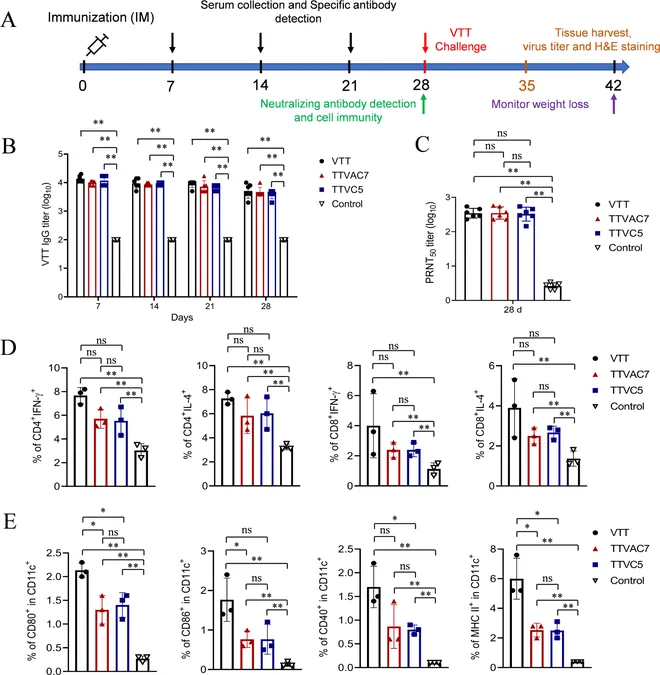
Breakthrough in Mpox Research: Gene-Deleted Vaccinia Virus Shows Promising Protection
2025-01-25
Author: Wei Ling
Introduction
The Monkeypox virus (MPXV), responsible for mpox infections, poses severe health threats globally, mirroring symptoms of smallpox such as fever, headache, and skin rashes. This has declared it a public health emergency of international concern. Notably absent, however, is a specific mpox vaccine. Fortunately, the long-standing smallpox vaccine has shown about 85% effectiveness against MPXV, providing hope in the face of this epidemic.
Historical Context of the Smallpox Vaccine
The origins of the smallpox vaccine in China date back to 1926 when the VTT strain was isolated from a soldier's scabs. This strain underwent extensive testing through sequential animal passages, leading to the potential realization of preventive measures against MPXV.
Challenges with Traditional Vaccines
Despite the potential benefits of the VTT vaccine, it brought about adverse reactions, notably in individuals with weakened immune systems, where it resulted in critical conditions like encephalitis and myocarditis.
Innovative Vaccine Development
In a groundbreaking study, researchers have developed two new vaccines: TTVAC7 and TTVC5. Utilizing advanced gene-deletion techniques, these vaccines exhibit reduced virulence compared to their predecessor, VTT. The deletion of several genes—responsible for immunomodulation, host range, and virulence—significantly enhances the vaccines’ safety profiles.
Efficacy Testing
However, their protective efficacy was initially uncertain until recent experiments involving BALB/c mice and New Zealand rabbits put these vaccines to the test. The research revealed that both TTVAC7 and TTVC5 not only prompted robust immune responses, marked by high levels of neutralizing antibodies, but also provided significant protection against MPXV when animals were vaccinated.
Methodological Approach
In terms of methodology, the study used various animal models, meticulously measuring immune markers through flow cytometry and enzyme-linked immunosorbent assays (ELISA) to assess the responses elicited by these vaccines. Observations pointed towards a marked increase in specific immune cells and cytokine levels, indicating strong immunity. Furthermore, the rabbits exhibited less fever, fewer pock lesions, and reduced lung and testis injuries post-infection, showcasing the vaccines' protective capabilities.
Key Findings and Implications
Interestingly, despite the deletion of genes that traditionally contribute to virulence, these vaccines maintained impressive efficacy. TTVAC7 and TTVC5 were revealed to not only be safe but highly effective, asserting their potential as leading candidates in combatting mpox.
Conclusion and Future Directions
As mpox continues to pose significant health risks, highlighting the alarming rise in suspected infections and fatalities across Africa—up 160% from the previous year—this research emphasizes the crucial role of vaccination as a preventive measure. The urgency for expanding vaccine reserves is clearer than ever as we navigate this global health crisis, with TTVAC7 and TTVC5 presenting a promising avenue for effective intervention against mpox. The efficacy, safety, and ease of production of these new vaccines could mark a transformative moment in public health response strategies, paving the way towards controlling the ongoing mpox outbreak and safeguarding communities worldwide.



 Brasil (PT)
Brasil (PT)
 Canada (EN)
Canada (EN)
 Chile (ES)
Chile (ES)
 Česko (CS)
Česko (CS)
 대한민국 (KO)
대한민국 (KO)
 España (ES)
España (ES)
 France (FR)
France (FR)
 Hong Kong (EN)
Hong Kong (EN)
 Italia (IT)
Italia (IT)
 日本 (JA)
日本 (JA)
 Magyarország (HU)
Magyarország (HU)
 Norge (NO)
Norge (NO)
 Polska (PL)
Polska (PL)
 Schweiz (DE)
Schweiz (DE)
 Singapore (EN)
Singapore (EN)
 Sverige (SV)
Sverige (SV)
 Suomi (FI)
Suomi (FI)
 Türkiye (TR)
Türkiye (TR)
 الإمارات العربية المتحدة (AR)
الإمارات العربية المتحدة (AR)